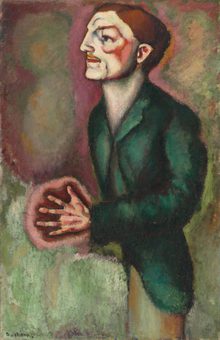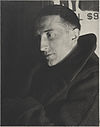
Cubism is an early-20th-century avant-garde art movement that revolutionized European painting and sculpture, and inspired related artistic movements in music, literature, and architecture. In Cubist works of art, the subjects are analyzed, broken up, and reassembled in an abstract form—instead of depicting objects from a single perspective, the artist depicts the subject from multiple perspectives to represent the subject in a greater context. Cubism has been considered the most influential art movement of the 20th century. The term cubism is broadly associated with a variety of artworks produced in Paris or near Paris (Puteaux) during the 1910s and throughout the 1920s.

Henri-Robert-Marcel Duchamp was a French painter, sculptor, chess player, and writer whose work is associated with Cubism, Dada, and conceptual art. He is commonly regarded, along with Pablo Picasso and Henri Matisse, as one of the three artists who helped to define the revolutionary developments in the plastic arts in the opening decades of the 20th century, responsible for significant developments in painting and sculpture. He has had an immense impact on 20th- and 21st-century art, and a seminal influence on the development of conceptual art. By the time of World War I, he had rejected the work of many of his fellow artists as "retinal", intended only to please the eye. Instead, he wanted to use art to serve the mind.
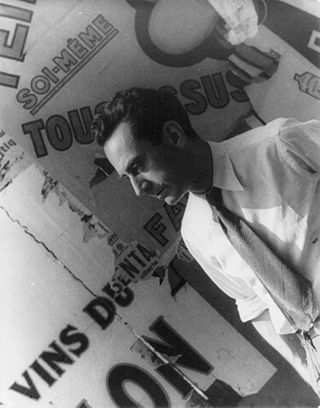
Man Ray was an American visual artist who spent most of his career in Paris. He was a significant contributor to the Dada and Surrealist movements, although his ties to each were informal. He produced major works in a variety of media but considered himself a painter above all. He was best known for his pioneering photography, and was a renowned fashion and portrait photographer. He is also noted for his work with photograms, which he called "rayographs" in reference to himself.

Francis Picabia was a French avant-garde painter, writer, filmmaker, magazine publisher, poet, and typographist closely associated with Dada.
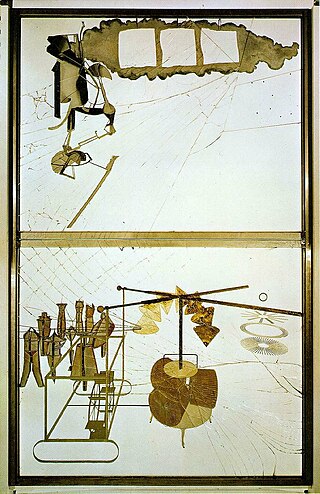
The Bride Stripped Bare by Her Bachelors, Even, most often called The Large Glass, is an artwork by Marcel Duchamp over 9 feet (2.7 m) tall and almost 6 feet (1.76m) wide. Duchamp worked on the piece from 1915 to 1923 in New York City, creating two panes of glass with materials such as lead foil, fuse wire, and dust. It combines chance procedures, plotted perspective studies, and laborious craftsmanship. Duchamp's ideas for the Glass began in 1912, and he made numerous notes and studies, as well as preliminary works for the piece. The notes reflect the creation of unique rules of physics, and myth which describes the work.

Fountain is a readymade sculpture by Marcel Duchamp in 1917, consisting of a porcelain urinal signed "R. Mutt". In April 1917, an ordinary piece of plumbing chosen by Duchamp was submitted for an exhibition of the Society of Independent Artists, the inaugural exhibition by the Society to be staged at the Grand Central Palace in New York. When explaining the purpose of his readymade sculpture, Duchamp stated they are "everyday objects raised to the dignity of a work of art by the artist's act of choice." In Duchamp's presentation, the urinal's orientation was altered from its usual positioning. Fountain was not rejected by the committee, since Society rules stated that all works would be accepted from artists who paid the fee, but the work was never placed in the show area. Following that removal, Fountain was photographed at Alfred Stieglitz's studio, and the photo published in the Dada journal The Blind Man. The original has been lost.

Nude Descending a Staircase, No. 2 is a 1912 painting by Marcel Duchamp. The work is widely regarded as a Modernist classic and has become one of the most famous of its time. Before its first presentation at the 1912 Salon des Indépendants in Paris it was rejected by the Cubists as being too Futurist. It was then exhibited with the Cubists at Galeries Dalmau's Exposició d'Art Cubista, in Barcelona, 20 April–10 May 1912. The painting was subsequently shown, and ridiculed, at the 1913 Armory Show in New York City.

John Quinn was an Irish-American cognoscente of the art world and a lawyer in New York City who fought to overturn censorship laws restricting modern literature and art from entering the United States.
Sherrie Levine is an American photographer, painter, and conceptual artist. Some of her work consists of exact photographic reproductions of the work of other photographers such as Walker Evans, Eliot Porter and Edward Weston.

Elsa Baroness von Freytag-Loringhoven was a German-born avant-garde visual artist and poet, who was active in Greenwich Village, New York, from 1913 to 1923, where her radical self-displays came to embody a living Dada. She was considered one of the most controversial and radical women artists of the era.

Chess became a source of inspiration in the arts in literature soon after the spread of the game to the Arab World and Europe in the Middle Ages. The earliest works of art centered on the game are miniatures in medieval manuscripts, as well as poems, which were often created with the purpose of describing the rules. After chess gained popularity in the 15th and 16th centuries, many works of art related to the game were created. One of the best-known, Marco Girolamo Vida's poem Scacchia ludus, written in 1527, made such an impression on the readers that it singlehandedly inspired other authors to create poems about chess.

Apolinère Enameled was painted in 1916–17 by Marcel Duchamp, as a heavily altered version of an advertisement for paint. The picture depicts a girl painting a bed-frame with white enamelled paint. The depiction of the frame deliberately includes conflicting perspective lines, to produce an impossible object. To emphasise the deliberate impossibility of the shape, a piece of the frame is missing. The piece is sometimes referred to as Duchamp's "impossible bed" painting.

New York Dada was a regionalized extension of Dada, an artistic and cultural movement between the years 1913 and 1923. Usually considered to have been instigated by Marcel Duchamp's Fountain exhibited at the first exhibition of the Society of Independent Artists in 1917, and becoming a movement at the Cabaret Voltaire in February, 1916, in Zürich, the Dadaism as a loose network of artists spread across Europe and other countries, with New York becoming the primary center of Dada in the United States. The very word Dada is notoriously difficult to define and its origins are disputed, particularly amongst the Dadaists themselves.
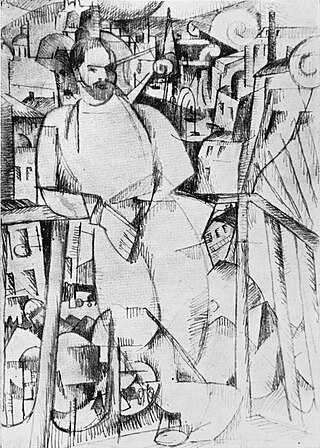
Man on a Balcony, is a large oil painting created in 1912 by the French artist, theorist and writer Albert Gleizes (1881–1953). The painting was exhibited in Paris at the Salon d'Automne of 1912. The Cubist contribution to the salon created a controversy in the French Parliament about the use of public funds to provide the venue for such 'barbaric art'. Gleizes was a founder of Cubism, and demonstrates the principles of the movement in this monumental painting with its projecting planes and fragmented lines. The large size of the painting reflects Gleizes's ambition to show it in the large annual salon exhibitions in Paris, where he was able with others of his entourage to bring Cubism to wider audiences.

Woman with Animals, originally referred to as La dame aux bêtes and Portrait de Mme D.V. or Madame Raymond Duchamp-Villon, is a painting created late 1913 and completed during the month of February, 1914, by the French artist, theorist and writer Albert Gleizes. The painting was exhibited at the Salon des Indépendants, Paris, 1 March – 30 April 1914. Woman with animals is executed in a personal Cubist style noted by the fusing background and figure, the multiple perspective or successive views at various moments in time of the Mrs. Duchamp-Villon's face and other elements, the freestyle brushstrokes delineating juxtaposing planes. The work was restored in 1940 by Jacques Villon and Robert Delaunay. Formerly in the collection of Marcel Duchamp, the work—along with a 1913 lavis and gouache study of the same subject entitled La femme aux bêtes—has been in the Peggy Guggenheim Collection, Venice, Italy, since 1940.
T.J. Demos is an art historian and cultural critic who writes on contemporary art and visual culture, particularly in relation to globalization, politics, migration and ecology. Currently a Professor in the Department of History of Art and Visual Culture (HAVC) at UC Santa Cruz, and the founding director of the Center for Creative Ecologies, he is the author of several books, including Against the Anthropocene: Visual Culture and Environment Today, Decolonizing Nature: Contemporary Art and the Politics of Ecology , The Migrant Image: The Art and Politics of Documentary during Global Crisis, and Return to the Postcolony: Spectres of Colonialism in Contemporary Art. Previous to his current appointment, Demos taught at University College London between 2005-2015.

Les Peintres Cubistes, Méditations Esthétiques, is a book written by Guillaume Apollinaire between 1905 and 1912, published in 1913. This was the third major text on Cubism; following Du "Cubisme" by Albert Gleizes and Jean Metzinger (1912); and André Salmon, Histoire anecdotique du cubisme (1912).

La Boîte-en-valise is a type of mixed media assemblage by Marcel Duchamp consisting of a group of reproductions of the artist's works inside a box that was, in some cases, accompanied by a leather valise or suitcase. Duchamp made multiple versions of this type between 1935 and 1966. Titled From or by Marcel Duchamp or Rrose Sélavy (de ou par Marcel Duchamp ou Rrose Sélavy [Boîte-en-valise], Duchamp conceived of the boxes as a portable museum:
Instead of painting something new, my aim was to reproduce the paintings and objects I liked and collect them in as small a space as possible. I did not know how to go about it. I first thought of a book, but I did not like the idea. Then it occurred to me that it could be a box in which all my works would be collected and mounted like in a small museum, a portable museum, so to speak. This is it, this valise.
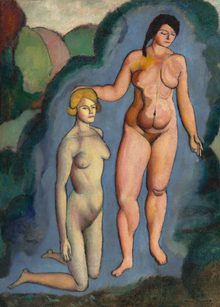
The Bush is a painting by Marcel Duchamp from 1910-1911. It is in the collection of the Philadelphia Museum of Art, that acquired it through The Louise and Walter Arensberg Collection in 1950. Its first owner was Dr. Raymond Dumouchel, himself the subject of another 1910 painting by Duchamp, Portrait of Dr. Dumouchel. One of the models may be Jeanne Serre, with whom Duchamp had a relationship and fathered a child, Yvonne, who later became known as Yo Savy. Duchamp noted that the painting marks the beginning of a practice of attaching non-descriptive titles to his work: "Introduce some anecdote without being 'anecdotal'"; the painting did not illustrate a definite theme, but the title created "the possibility to invent a theme for it, afterwards."
Dumouchel is a surname of French origin, originating as a habitational name for someone from any of several places named Le Mouchel. Notable people with the surname include:
